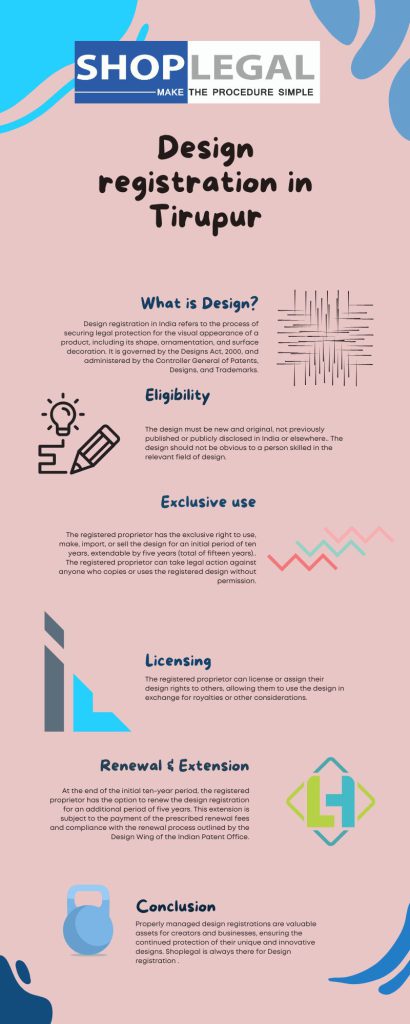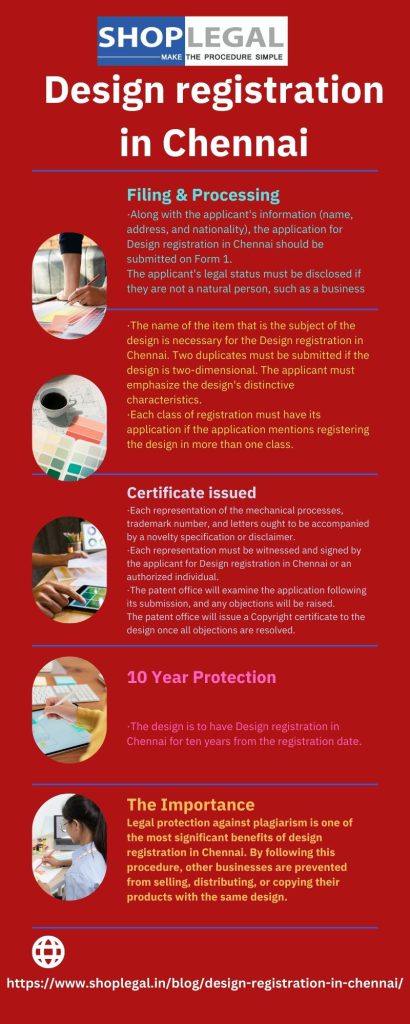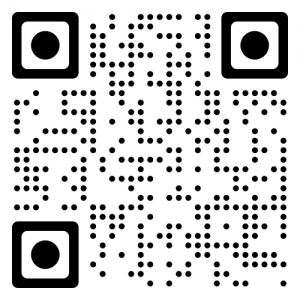Design registration in Tirupur
TALK TO EXPERTS
Design registration in Tirupur refers to the process of securing legal protection for the visual appearance of a product, including its shape, ornamentation, and surface decoration. It is governed by the Designs Act, 2000, and administered by the Controller General of Patents, Designs, and Trademarks.
Design registration is crucial for creators and businesses as it provides exclusive rights over the design, preventing others from copying or using it without permission.
Eligibility for Design Registration:
To be eligible for design registration in Tirupur, the design must meet the following criteria:
Novelty:
The design must be new and original, not previously published or publicly disclosed in India or elsewhere.
Non-Obviousness:
The design should not be obvious to a person skilled in the relevant field of design.
Not Contrary to Public Order or Morality: The design should not be contrary to public order, morality, or any established law.
Design Registration Process:
Search and Analysis:
Before applying for design registration, it is advisable to conduct a search to ensure the design is novel and unique. This can help avoid potential rejections.
Application Filing:
The applicant (creator or owner) needs to file an application for design registration in Tirupur with the Design Wing of the Indian Patent Office. The application should include:
A request for registration.
- Representation of the design (drawings, photographs, or specimens).
- A statement of novelty and distinctiveness.
- Name, address, and nationality of the applicant.
- The class and article to which the design relates.
Examination:
After filing, the application undergoes formal and substantive examinations. During the substantive examination, the design is assessed for novelty and distinctiveness. If the design is found to be non-novel or obvious, the application may be rejected.
Publication:
Once the design application is accepted for design registration in Tirupur, it is published in the Design Journal. This publication serves as a notice to the public about the existence of the design.
Opposition:
Within four months of publication, third parties can file an opposition against the design if they believe it does not meet the eligibility criteria. The Controller may then decide on the opposition.
Registration:
If there are no oppositions or if the oppositions are unsuccessful, the design is registered, and a certificate of registration is issued to the applicant.
Rights and Duration:
Design registration in India grants the following rights to the registered proprietor:
Exclusive Use:
The registered proprietor has the exclusive right to use, make, import, or sell the design for an initial period of ten years, extendable by five years (total of fifteen years).
Protection against Infringement:
The registered proprietor can take legal action against anyone who copies or uses the registered design without permission.
Licensing and Assignment:
The registered proprietor can license or assign their design rights to others, allowing them to use the design in exchange for royalties or other considerations.
Enforcement and Infringement:
If someone uses a design that has design registration in Tirupur without authorization, the registered proprietor can take legal action for design infringement. Remedies may include injunctions, damages, and orders to stop the infringing activities.
Thus, design registration in India provides creators and businesses with legal protection for their unique designs, preventing others from copying or using them without permission. The process involves filing an application, examination, publication, and potential opposition.
Once registered, the proprietor gains exclusive rights over the design, allowing them to enforce those rights against infringers. Design registration encourages innovation and creativity while safeguarding the interests of designers and businesses.
What is the period of design registration?
The period of design registration refers to the duration for which a registered design remains legally protected under the intellectual property laws of a specific jurisdiction, such as in India. The period of design registration varies from one country to another and can be subject to certain conditions and renewal requirements. In India, the period of design registration is governed by the Designs Act, 2000.
Initial Period of Protection:
In India, upon successfully registering a design, the initial period of protection is ten years from the date of registration. During this time, the registered proprietor (the person or entity that owns the design) enjoys exclusive rights over the design. These rights include the right to use, make, import, and sell products featuring the design which has design registration in Tirupur.
Renewal and Extension:
At the end of the initial ten-year period, the registered proprietor has the option to renew the design registration for an additional period of five years. This extension is subject to the payment of the prescribed renewal fees and compliance with the renewal process outlined by the Design Wing of the Indian Patent Office.
Total Duration of Protection:
The total duration of design protection in India, including both the initial period and the extended period after renewal, can be up to fifteen years from the date of registration.
Renewal Process:
To extend the protection of a registered design beyond the initial ten-year period, the registered proprietor must follow the renewal process, which typically involves the following steps:
Application for Renewal:
The registered proprietor should file an application for the renewal of the design registration in Tirupur with the Design Wing of the Indian Patent Office. This application should be submitted within the prescribed timeframe, which is usually before the expiration of the initial ten-year period.
Payment of Renewal Fee:
Along with the renewal application, the registered proprietor must pay the renewal fee as specified by the authorities. The fee amount may vary and should be confirmed from the official sources.
Verification and Approval:
The Design Wing of the Indian Patent Office will verify the application and fee payment. If all requirements are met and there are no objections, the design registration in Tirupur will be renewed for an additional five years.
Issuance of Renewal Certificate:
Once the renewal is approved, the Design Wing will issue a renewal certificate to the registered proprietor. This certificate serves as evidence of the extended protection period.
Importance of Renewal:
Renewing a design registration is essential for maintaining the exclusive rights and legal protection over the design. Failure to renew the design registration within the stipulated timeframe could result in the loss of protection, making the design part of the public domain. In such a case, others may freely use, reproduce, or modify the design without infringing any intellectual property rights.
Infringement and Enforcement:
During the protection period (both initial and extended), the registered proprietor has the legal authority to take action against any unauthorized use or infringement of the registered design. Remedies may include seeking injunctions, claiming damages, or requesting the court to stop the infringing activities. Properly renewed design registrations are crucial for enforcing these rights effectively.
Conclusion
In conclusion, the period of design registration in Tirupur initially lasts for ten years from the date of registration, with the option to extend it for an additional five years through the renewal process. The total duration of protection can be up to fifteen years. Renewing a design registration is essential to maintain exclusive rights and enforce intellectual property protection over the design. Properly managed design registrations are valuable assets for creators and businesses, ensuring the continued protection of their unique and innovative designs.














